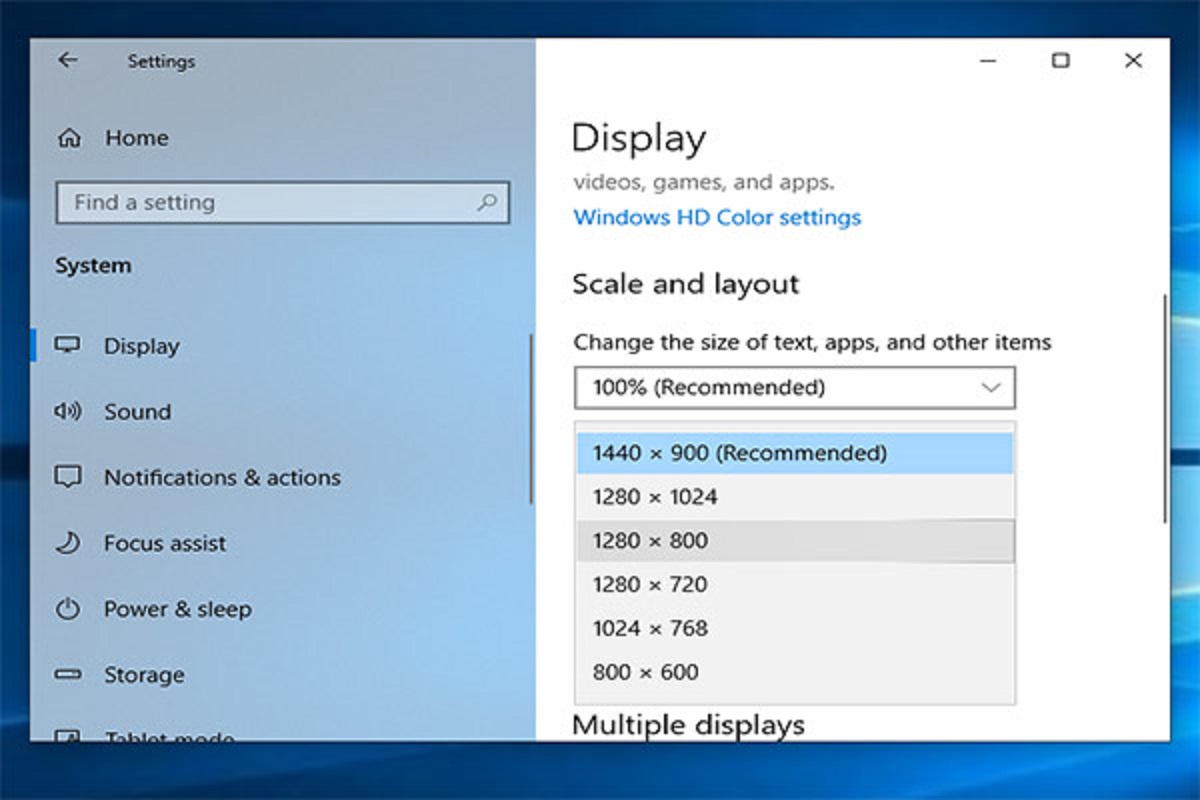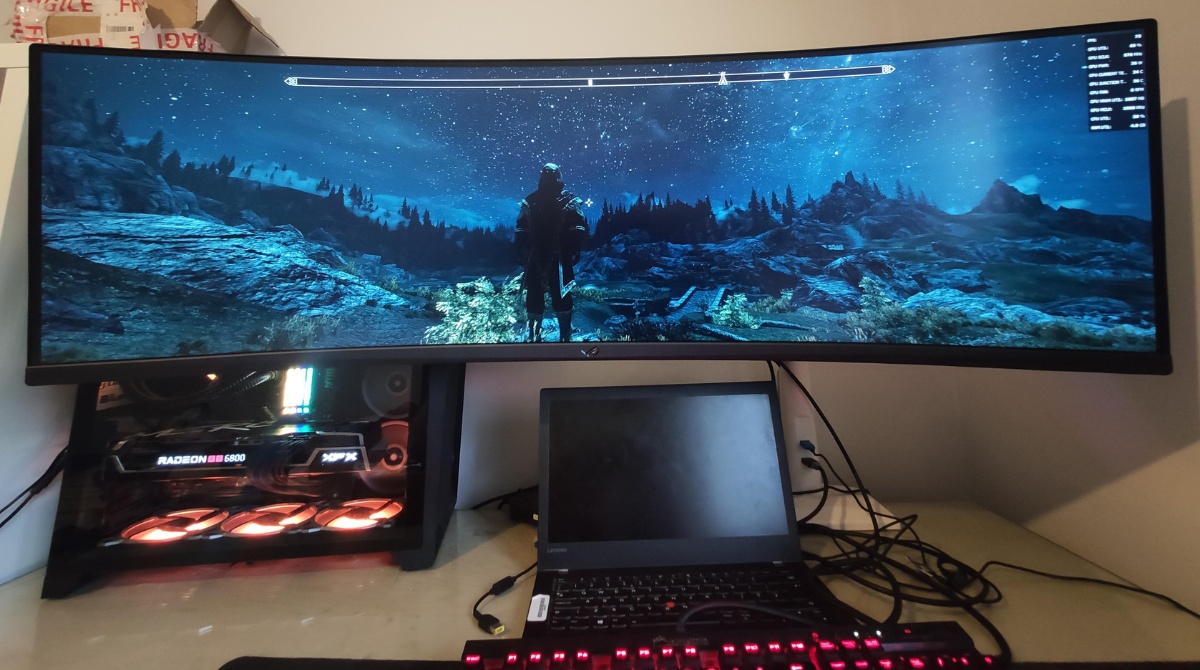Introduction
When it comes to using a computer or any digital device, understanding and optimizing the screen resolution is essential for a seamless visual experience. Screen resolution refers to the number of pixels displayed on a screen and determines the clarity and sharpness of images, text, and graphics. Knowing the resolution of your monitor is especially important when working with high-definition content, playing games, or undertaking graphic design projects.
In this article, we will guide you through the process of identifying your screen resolution on various operating systems, including Windows, Mac, and Linux. We will also explore third-party tools that can help you determine your monitor’s resolution effortlessly.
By having a clear understanding of your screen resolution, you can ensure that all visual elements are displayed correctly, avoiding any issues related to distorted images or text. Whether you want to upgrade your monitor, set up multiple displays, or troubleshoot display-related problems, knowing how to identify your screen resolution is a fundamental skill.
So, if you’re ready to uncover the secrets of your monitor’s resolution, let’s dive right in and learn how to determine the resolution on different operating systems!
Understanding Screen Resolution
Before we delve into the methods of checking your screen resolution, let’s take a moment to understand what screen resolution is and how it impacts your viewing experience.
Screen resolution refers to the number of pixels displayed on a screen, typically measured in width and height. It determines the level of detail and clarity of the visual content shown on your monitor. A higher resolution means more pixels are packed into the screen, resulting in sharper images, text, and graphics. Conversely, a lower resolution will display fewer pixels, leading to a less crisp and clear image.
The most common screen resolutions are 1080p (1920×1080 pixels), 1440p (2560×1440 pixels), and 4K (3840×2160 pixels). These resolutions are widely used in modern monitors and provide stunning visuals for gaming, watching movies, and general computing tasks.
It’s important to note that screen resolution alone does not determine the size of the displayed content. The physical dimensions of the screen, measured in inches, also play a significant role. For example, a 24-inch monitor with a resolution of 1080p will display images and text differently from a 32-inch monitor with the same resolution. The pixels will be more spread out on the larger screen, potentially resulting in a slightly less sharp image.
Understanding your screen resolution is crucial when considering factors like image clarity, visual comfort, and compatibility with software applications. It also allows you to make informed decisions when purchasing a new monitor or adjusting display settings.
Now that we have a basic understanding of screen resolution, let’s explore the various methods to determine the resolution on different operating systems.
Checking Screen Resolution on Windows
On Windows operating systems, checking the screen resolution is a straightforward process that can be done through the Display Settings or the Control Panel. Here’s how you can find your monitor’s resolution on Windows:
1. Using Display Settings:
– Right-click on the desktop and select “Display Settings” from the context menu.
– Scroll down to the “Display Resolution” section.
– The current screen resolution will be displayed in pixels, such as 1920×1080.
2. Using Control Panel:
– Open the Control Panel by searching for it in the Start menu.
– Click on “Appearance and Personalization” and then “Display.”
– Under the “Change the size of text, apps, and other items” section, click on “Advanced display settings.”
– The current screen resolution will be listed under the “Resolution” dropdown.
In both methods, Windows will display the available screen resolutions for your monitor. You can select a different resolution from the list if needed. Keep in mind that changing the resolution may affect the clarity and size of the displayed content, so choose the option that best suits your preferences and monitor capabilities.
If you prefer a quicker method, you can also check the screen resolution using keyboard shortcuts. Press the “Windows” key + “P” to open the “Project” menu, which will display the current resolution alongside options for multiple displays.
By following these steps, you can easily determine the screen resolution of your Windows monitor. This knowledge will come in handy when configuring your display settings, troubleshooting display issues, or connecting your computer to external monitors or projectors.
Checking Screen Resolution on Mac
If you’re using a Mac computer, finding the screen resolution is a seamless process. Here are the steps to check your monitor’s resolution on a Mac:
1. Using System Preferences:
– Click on the Apple menu in the top-left corner of the screen and select “System Preferences.”
– In the System Preferences window, click on “Displays.”
– The current screen resolution will be displayed under the “Display” tab.
2. Using About This Mac:
– Click on the Apple menu and select “About This Mac.”
– In the Overview tab, click on “System Report.”
– In the System Information window, select “Graphics/Displays” in the sidebar.
– The current screen resolution will be listed beside the “Resolution” field.
Alternatively, you can also check the screen resolution by performing a simple keyboard shortcut:
– Press and hold the “Option/Alt” key while clicking on the Apple menu.
– From the dropdown menu, select “System Information.”
– In the System Information window, follow the steps mentioned above to find the screen resolution under “Graphics/Displays.”
MacOS provides a user-friendly interface that allows you to easily identify and adjust the screen resolution as per your preferences. Additionally, you can choose whether to use the “Default for display” option or customize the resolution according to your needs.
Knowing your screen resolution on a Mac is crucial for tasks such as graphic design, video editing, or simply adjusting the display settings for optimal visual comfort. Whether you’re using a MacBook, iMac, or Mac mini, these methods will help you determine the screen resolution without any hassle.
Checking Screen Resolution on Linux
Linux offers a variety of desktop environments and window managers, each with its own way of accessing display settings. However, there are a few common methods to check the screen resolution on Linux systems. Here’s how you can do it:
1. Using System Settings:
– Look for the “Settings” application in your Linux distribution’s main menu.
– Open the “Display” or “Screen” section within the Settings application.
– The current screen resolution will be listed in pixels under the display settings.
2. Using Terminal Commands:
– Open a terminal window, either by searching for “Terminal” in your distribution’s main menu or using the keyboard shortcut (Ctrl+Alt+T).
– Enter the following command: `xrandr`
– The terminal will display information about your connected displays, including the screen resolution.
Alternatively, you can try the following command if `xrandr` is not available:
– `xdpyinfo | grep dimensions`
These commands will provide you with details about your screen resolution, including the width and height in pixels.
As Linux offers a wide range of distributions and desktop environments, the steps to check the screen resolution may vary slightly. It’s best to consult the documentation or community forums specific to your Linux distribution if you encounter any difficulties or if the above methods don’t work.
Understanding the screen resolution on your Linux system is vital for tasks like gaming, graphic design, and software development. It allows you to fine-tune the display settings to ensure optimal clarity and visual fidelity.
By utilizing these methods, you can easily identify and adjust the screen resolution on your Linux system, enabling you to enjoy an optimal viewing experience.
Using Third-Party Tools to Determine Screen Resolution
In addition to the built-in methods provided by operating systems, there are also third-party tools available that can help you determine your screen resolution. These tools offer additional features and customization options for those who require more advanced functionality. Here are a few popular options:
1. DisplayInfo:
– DisplayInfo is a free and lightweight program available for Windows. It provides detailed information about your monitor, including screen resolution, refresh rate, color depth, and more. You can download DisplayInfo from various software download websites.
2. Monitortest:
– Monitortest is a comprehensive software tool compatible with Windows systems. Apart from displaying the current screen resolution, it offers various tests to assess the performance and capabilities of your monitor. These tests help identify any potential issues related to pixel defects, color accuracy, and response time.
3. QuickRes:
– QuickRes is a handy utility available for macOS. It allows you to quickly switch between screen resolutions from the menu bar, making it convenient to test different resolutions for compatibility or visual preferences.
4. ScreenFetch/Neofetch:
– For Linux users, utilities like ScreenFetch or Neofetch display detailed system information, including screen resolution, in a stylish ASCII art format. These tools are particularly useful if you want to get an overview of your system’s specifications alongside the screen resolution.
These third-party tools can be beneficial in situations where you need more information about your monitor’s capabilities or require additional customization options for your display settings.
It’s important to note that before installing any third-party tool, always ensure that you download from trusted sources and verify the authenticity of the software to prevent any potential security risks. Additionally, read user reviews and refer to community forums to make sure the tool is compatible with your operating system and monitor.
By utilizing these third-party tools, you can gain deeper insights into your screen resolution and unlock advanced features that enhance your overall viewing experience.
Conclusion
Determining the screen resolution of your monitor is essential for optimizing your visual experience on digital devices. Whether you’re using Windows, Mac, or Linux, there are simple methods available to check your screen resolution and ensure that the displayed content is crisp and clear.
On Windows, you can easily access the screen resolution through the Display Settings or Control Panel. Mac users can find this information in the System Preferences or by using the About This Mac feature. Linux users can access the screen resolution through the system settings or by using terminal commands such as `xrandr` or `xdpyinfo`.
In addition to the built-in methods, there are third-party tools available that offer more advanced features and customization options. Tools like DisplayInfo, Monitortest, QuickRes, and ScreenFetch/Neofetch provide additional information about your monitor’s capabilities and help you fine-tune your display settings to match your preferences.
Understanding your screen resolution allows you to work with high-definition content, play games, and undertake graphic design projects with clarity and precision. It also helps troubleshoot any display-related issues and ensures compatibility when using external monitors or projectors.
By following the methods outlined in this article, you can easily determine your monitor’s screen resolution and make necessary adjustments to enhance your visual experience. Whether you’re a professional designer or a casual computer user, having this knowledge empowers you to take full advantage of your monitor’s capabilities and enjoy a seamless viewing experience.
Remember to always download third-party tools from trusted sources and verify their compatibility with your operating system and monitor to ensure a secure and reliable experience.
So, the next time you’re curious about your screen resolution, simply refer to this guide and explore the methods suitable for your operating system. Embrace the clarity and sharpness that comes with knowing your screen resolution and elevate your digital experience.

























